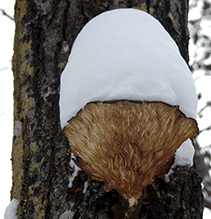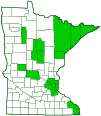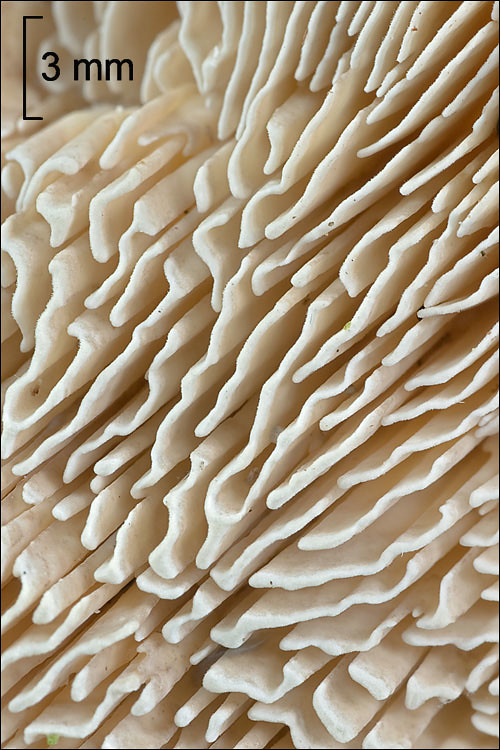Gilled Polypore
(Trametes betulina)
Conservation • Description • Habitat • Ecology • Distribution • Taxonomy
Conservation Status |
|
|||||||
| IUCN Red List | not listed |
|||||||
| NatureServe | not listed |
|||||||
| Minnesota | not listed |
|||||||
Description |
||
The name Gilled Polypore sounds like an oxymoron but accurately describes this mushroom. It looks very much like a Turkey Tail but the pore surface on the underside has gills. It is widespread across Europe, Asia, and North and South America. In the United States it is very common from the East Coast to the Great Lakes states, south to Texas, and on the West Coast. It is less common in Minnesota where it is at the western edge of its range. It obtains its nutrients from dead wood (saprobic). It grows on logs and stumps of a wide variety of hardwoods, especially oak and willow, rarely also on conifers. It is usually found in overlapping rows or columns, sometimes scattered. The fruiting body is a small, stalkless, leathery, shelf-like bracket. The bracket is fan-shaped to nearly round, flat to convex, 1¼″ to 4″ wide, and up to ¾″ thick. The upper surface is concentrically zoned with varying textures and and colors including white, tan, gray, brown, yellowish-brown, and orange. It is densely covered with hairs and is often bumpy and ridged. Older specimens are often green due to a covering of algae. The gills are tough, sharp, up to ⅜″ deep, and closely or somewhat widely spaced. When young they are white and sometimes form elongated pockets. As they age they darken and become wavy. The flesh is white, thin, leathery, and tough, becoming corky on older specimens. It is inedible. The spore print is white. |
||
Similar Species |
||
Conifer Mazegill (Gloeophyllum sepiarium) gills are yellowish-brown or rusty brown, not white. It grows mostly on conifers, occasionally also on hardwoods. Turkey Tail (Trametes versicolor) has pores on the underside, not gills. |
||
Habitat and Hosts |
||
Deciduous and mixed woodlands |
||
Ecology |
||
Season |
||
July through December |
||
Distribution |
||||
|
Sources |
|||
| 10/29/2021 | ||||
Occurrence |
||||
Common |
||||
Taxonomy |
|||
| Kingdom | Fungi (Fungi) | ||
| Subkingdom | Dikarya | ||
| Phylum | Basidiomycota (Basidiomycete Fungi) | ||
| Subphylum | Agaricomycotina (Higher Basidiomycetes) | ||
| Class | Agaricomycetes (Mushrooms, Bracket Fungi, Puffballs, and Allies) | ||
| Subclass | incertae sedis (uncertain placement) | ||
| Order | Polyporales (shelf fungi) | ||
| Family | Polyporaceae (bracket fungi) | ||
| Genus | Trametes | ||
Gilled Polypore was formerly known as Lenzites betulina. In 2011, based on phylogenetic analysis, it was transferred to the genus Trametes. |
|||
Synonyms |
|||
Lenzites betulina Lenzites betulinus |
|||
Common Names |
|||
Birch Mazegill Gilled Polypore Multicolor Gill Polypore |
|||
Glossary
Saprobic
A term often used for saprotrophic fungi. Referring to fungi that obtain their nutrients from decayed organic matter.
Visitor Photos |
|||||
Share your photo of this fungus. |
|||||
| This button not working for you? Simply email us at info@MinnesotaSeasons.com. Attach one or more photos and, if you like, a caption. |
|||||
Luciearl |
|||||
 |
|||||
MinnesotaSeasons.com Photos |
|||||
|
|||||


Visitor Videos |
|||
Share your video of this fungus. |
|||
| This button not working for you? Simply email us at info@MinnesotaSeasons.com. Attach a video, a YouTube link, or a cloud storage link. |
|||
Other Videos |
|||
| Maze mushroom-Trametes betulina in Goa university campus Nandkumar Kamat |
|||
About
Published on Feb 3, 2011 This lignicolous basidiomycetes is well adapted to GU campus and mineralizes the wood |
|||
| Trametes betulina for Influenza Doctor Mushroom - Natural Healing |
|||
About
Published on Aug 28, 2016 Trametes betulina is one of many medicinal mushrooms that can help fight the flu. |
|||


Created: 1/4/2019
Last Updated:


